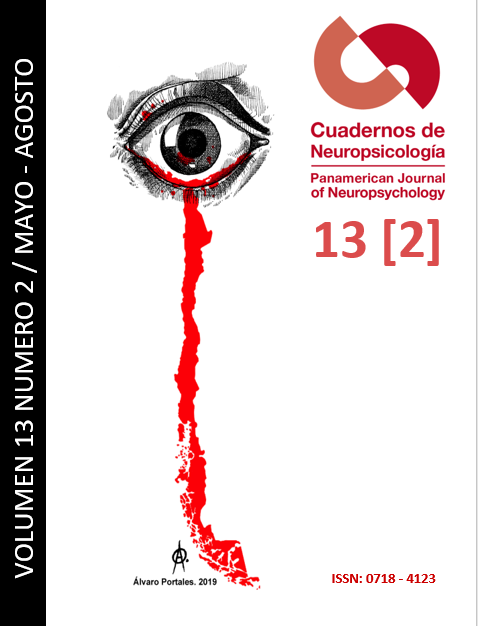Efectos categoriales en tareas de denominación y categorización de dibujos con y sin color
Abstract
Resumen:
Los efectos categoriales (EC) observados en pacientes y en sujetos sin lesión cerebral podrÃan deberse a las caracterÃsticas estructurales de los ejemplares de los dominios de seres vivos (SV) y objetos inanimados (OI) en función de su mayor o menor semejanza estructural. La Hipótesis Pre-Semántica de los Efectos Categoriales (PACE) propone que los SV y OI se verán favorecidos/desfavorecidos en función de las demandas perceptuales de cada tarea que se administre. El objetivo de este trabajo es indagar posibles EC en tareas de denominación y categorización utilizando tanto dibujos en blanco y negro como a color. Se evaluaron cuatro muestras de participantes adultos con tareas de denominación y categorización. Se observaron EC en denominación y categorización de dibujos en blanco y negro y en categorización de dibujos a color. El efecto desaparece en denominación con dibujos a color. Los resultados acuerdan parcialmente con los postulados de la hipótesis PACE. A la luz de estos, se discuten las implicancias cognitivas de las tareas utilizadas.
Palabras claves: Semejanza estructural; Denominación; Categorización; Dibujos Blanco y Negro; Dibujos en color; Dominios semánticos
Â
Abstract:
Category-effects (CE) observed both in patients and normal subjects could be explained by structural similarity between the members of living things (LT) and inanimate objects (IO) semantic domains. The Pre-Semantic Account of the Categorial Effects (PACE) proposes that the perceptual demands of the possible task will work in favour/against each domain. The aim of this study is to assess the existence of CE in picture naming and picture categorization tasks using black and white and color pictures. Four groups of participants were assessed with picture naming task and categorization task. CE was observed in black and white picture naming task, black and white picture categorization task and in color picture categorization task. The CE disappeared in the color picture-naming task. The results partially agree with the PACE. These results are discussed considering the cognitive implications of the tasks used in this research.
Key words: structural similarity; naming task, categorization task; black and white pictures; color pictures; semantic domains
Â
Resumo:
Os efeitos categóricos (DC) observados em pacientes e indivÃduos sem lesão cerebral podem ser devidos à s caracterÃsticas estruturais das amostras dos domÃnios de seres vivos (SV) e objetos inanimados (OI), dependendo de sua maior ou menor semelhança estrutural . A hipótese pré-semântica de efeitos de categoria (PACE) propõe que a SV e a OI sejam favorecidas / desfavorecidas, dependendo das demandas perceptivas de cada tarefa administrada. O objetivo deste trabalho é investigar possÃveis CEs em tarefas de nomeação e categorização usando desenhos em preto e branco e em cores. Quatro amostras de participantes adultos com tarefas de nomeação e categorização foram avaliadas. CE foram observados na denominação e categorização dos desenhos em preto e branco e na categorização dos desenhos em cores. O efeito desaparece na denominação com desenhos coloridos. Os resultados concordam parcialmente com os postulados da hipótese PACE. À luz disso, são discutidas as implicações cognitivas das tarefas utilizadas.
Palavras-chave: Semelhança estrutural; Denominação; Categorização; Desenhos em preto e branco; Desenhos a cores; DomÃnios semânticos
Downloads
How to Cite
Issue
Section
License
Articles published in this journal are protected under the Creative Commons Attribution-NonCommercial-ShareAlike 4.0 International (CC BY-NC-SA 4.0) license. This means that authors retain full rights over their research and publications at all times. As a journal, we fully respect and promote the principles of open access established by this license, allowing the work to be shared, adapted, and distributed for non-commercial purposes, provided that appropriate credit is given to the authors and any derivative works are licensed under the same terms.
Authors are responsible for obtaining the required permission when they wish to reproduce part of the material (figures, etc.) from other publications.
Likewise, CNPs allows authors to host in their personal sites or other repositories that they deem convenient the Final and Definitive Version of the published article with the format assigned by the journal. In no case do we allow access to preprints of the article under evaluation or already published.
When submitting an article to CNPs you are aware that all the contents of CNPs are under a Creative Commons License. In which it is allowed to copy and share the contents freely, always making reference to the origin of the publication and its author.





